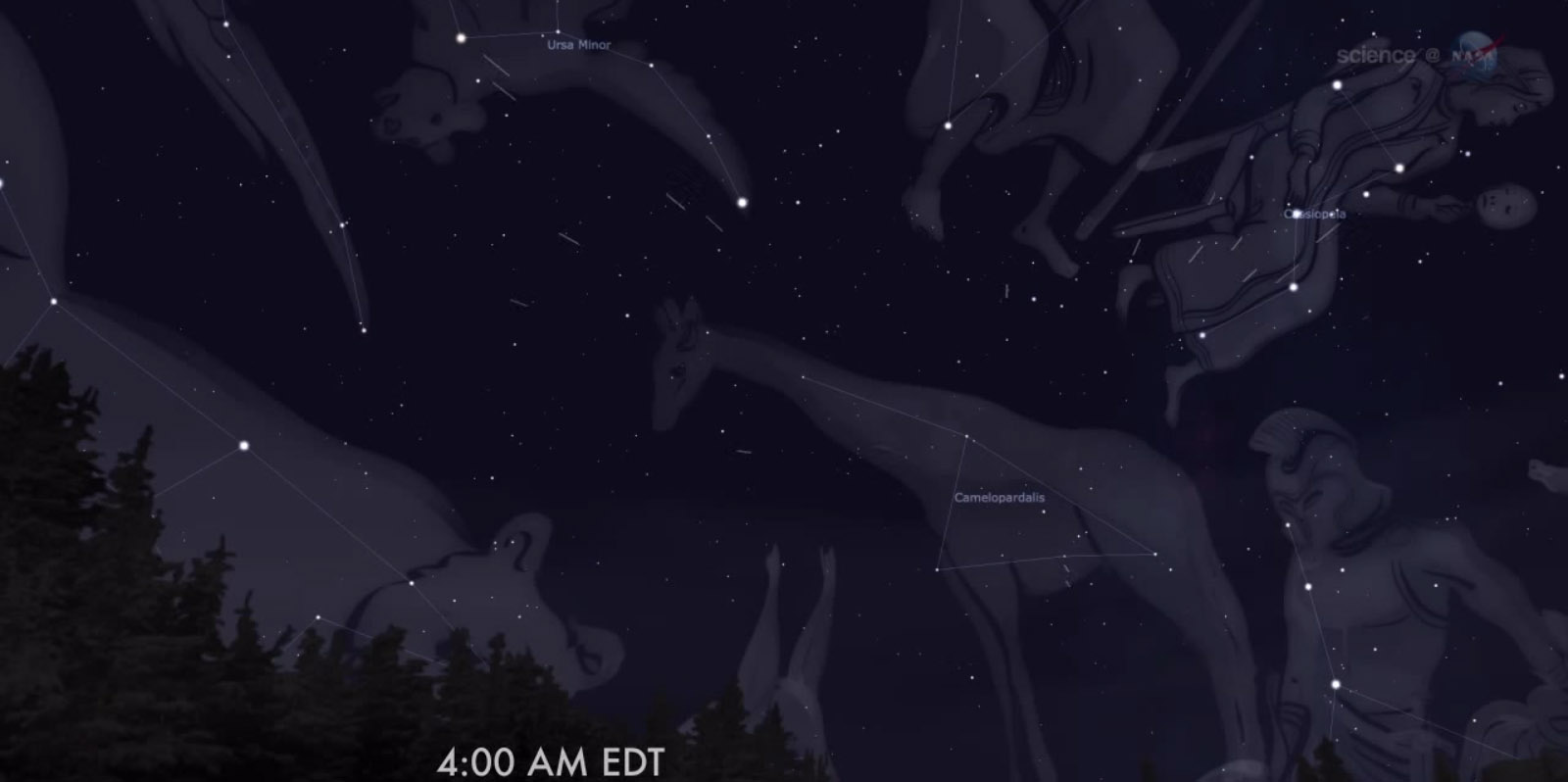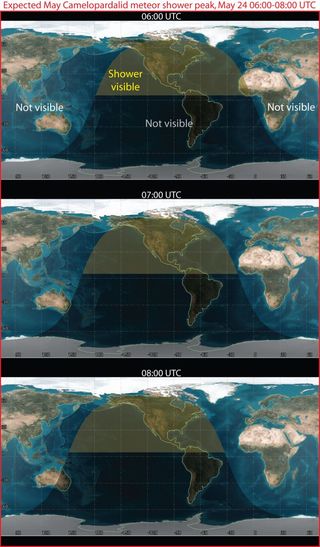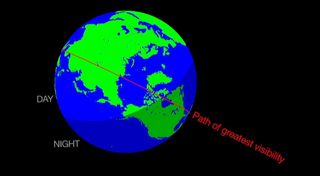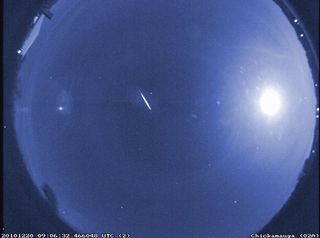
Stargazers may see some celestial fireworks this Memorial Day weekend thanks to a new meteor shower from a comet that, according to some forecasts, has the potential to trigger a spectacular meteor storm late tonight and early Saturday (May 23 and 24). If bad weather spoils your view, you can watch it live online.
Indeed, there appears to be a chance that a very significant new meteor shower – possibly even the best of 2014 – could take place. The progenitor of this possible display is Comet 209P/LINEAR, a tiny periodic comet discovered in 2004 by the Lincoln Near-Earth Asteroid Research project (LINEAR).
If rain or clouds spoil your stargazing view during the new shower, called the Camelopardalid meteor shower, there are webcasts tonight streaming live views of the celestial event. [How to See the New Camelopardalid Meteor Shower]

The online community telescope Slooh.com will offer two webcasts, one at 6 p.m. EDT (2200 GMT) and another at 11 p.m. EDT (0300 May 24 GMT) to chronicle the meteor shower. You can also watch the Slooh meteor webcast feed and others on Space.com. NASA will also offer live views from all-sky cameras at the agency's Marshall Space Flight Center in Huntsville, Alabama. The Virtual Telescope Project in Italy will also offer a live feed beginning at 1:30 a.m. EDT (0530 GMT) on Saturday morning (May 24).
Comet 209P/LINEAR takes about five years to circle the sun and several reputable meteor scientists agree that Earth is now on a collision course with a number of dusty debris trails shed by 209P/LINEAR, which may cause an outburst of meteor activity during the overnight hours tonight. Computer simulations show all the trails of dust ejected by this comet between 1803 and 1924 – 25 in all – falling directly in the Earth's path tonight.
One scientist, Mikiya Sato of Japan, has one of these trails, shed by the comet in 1903, coming to within just 4,200 miles (6,700 km) of Earth’s orbit. As a consequence, an unusually strong meteor display appears to be within the realm of possibility.
Editor's Note: If you capture an amazing photo of the new meteor shower, or any other night sky view, that you'd like to share for a possible story or image gallery, please contact managing editor Tariq Malik at spacephotos@space.com.
Get the Space.com Newsletter
Breaking space news, the latest updates on rocket launches, skywatching events and more!

How many meteors?
In the 2014 Observer’s Handbook of the Royal Astronomical Society of Canada, authors Margaret Campbell-Brown and Peter Brown: "It is highly likely this will be the strongest meteor display of 2014 visible from North America." [How Meteor Storms Work (Infographic)]
But just how much dust has the comet released into space remains questionable. Two astronomers at the University of Western Ontario, Quanzhi Ye and Paul Wiegert, have determined that the comet is relatively depleted in dust production and might produce only a handful of bright meteors.
Meanwhile, French astronomer Jérémie Vaubailion is forecasting anywhere from 100 to 400 "shooting stars" per hour, while two other meteor sleuths, Mikhail Maslov of Russia and Esko Lytinnen of Finland, think that a full-blown meteor storm of up to 1,000 per hour cannot be completely discounted.
When and where to look
The meteors are predicted to stream from the direction of the dim and almost formless constellation of Camelopardalis, the Giraffe for about three hours tonight around 3:10 a.m. Eastern Time (12:10 a.m. Pacific Time). That means that the United States and southern Canada will be in the best position to see whatever activity occurs, since it will be taking place in a dark sky between midnight and dawn.

Camelopardalis will be situated low in the north-northwest sky below and slightly to the left of Polaris (the North Star). So the meteors will appear to be streaming up from out of the northern part of the sky.
Bright and slow
There will be no mistaking the meteors from this new shower if they show up. The meteors are likely to be bright and unusually slow-moving. They'll be bright because the simulations suggest that the debris should be skewed strongly toward relatively large particles, larger than 1 millimeter.
If this doesn't sound very large to you, keep in mind that the high speeds that these particles ram into the Earth's atmosphere, friction releases the kinetic energy of the object in a short-lived flash of light. The energy released per gram of the meteoroid's weight far exceeds the energy efficiency of the most powerful man-made explosives. So, an object the size of a pebble can blaze across the sky with a brilliance rivaling Jupiter, or Venus. So there is a chance that we could be treated to some outstandingly bright meteors.

As for their apparent speed, the meteors will hit the atmosphere at a mere 11 miles per second (18 kilometers per second), far slower than those of any of the annual showers. The December Geminids arrive at about twice that speed, the Perseid meteor shower in August three times and the November Leonids four times.
So instead of swift streaks that blaze into incandescence within a heartbeat and are gone just a second or two later, tonight’s meteors might move across the sky in a relatively slow, almost majestic manner.
The moon will be a waning crescent, just 4.5 days from its dark "new" phase, and it doesn't rise until around 3 a.m. so it will be of little or no hindrance for prospective observers.
All you'll need is a clear sky. Good luck and good observing!
Joe Rao serves as an instructor and guest lecturer at New York's Hayden Planetarium. He writes about astronomy for Natural History magazine, the Farmer's Almanac and other publications, and he is also an on-camera meteorologist for News 12 Westchester, N.Y. Follow us @Spacedotcom, Facebook and Google+. Original article on Space.com.

Join our Space Forums to keep talking space on the latest missions, night sky and more! And if you have a news tip, correction or comment, let us know at: community@space.com.

Joe Rao is Space.com's skywatching columnist, as well as a veteran meteorologist and eclipse chaser who also serves as an instructor and guest lecturer at New York's Hayden Planetarium. He writes about astronomy for Natural History magazine, Sky & Telescope and other publications. Joe is an 8-time Emmy-nominated meteorologist who served the Putnam Valley region of New York for over 21 years. You can find him on Twitter and YouTube tracking lunar and solar eclipses, meteor showers and more. To find out Joe's latest project, visit him on Twitter.










